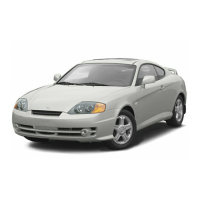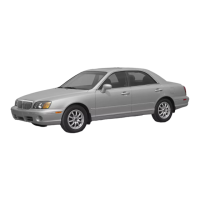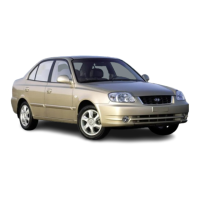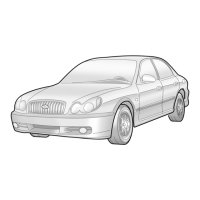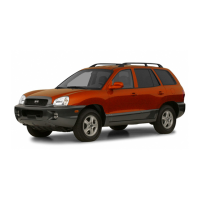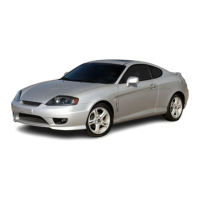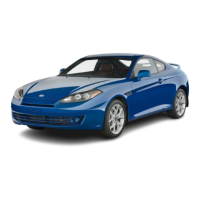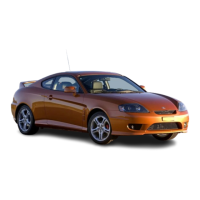Do you have a question about the Hyundai 2003 Tiburon and is the answer not in the manual?
Details the various limited warranties provided for your Hyundai vehicle.
Outlines the owner's responsibility for carrying out specified maintenance operations.
Sections covering vehicle operation, maintenance schedules, and technical specifications.
Welcomes the owner and highlights Hyundai's commitment to engineering and quality.
Warns against modifications that may affect performance, safety, or warranties.
Advises on installing two-way radios or cellular telephones to avoid electronic interference.
Explains the meaning of WARNING, CAUTION, and NOTE titles used in the manual.
Provides information on identifying and using Hyundai genuine parts.
Details recommended fuel types, including unleaded gasoline and gasohol.
Provides recommendations for the initial break-in period to ensure durability.
Explains key usage, spare keys, and door locking safety precautions.
Describes how to lock and unlock front doors using the vehicle's key.
Details methods for locking doors from both exterior and interior perspectives.
Explains the operation of the central door lock switch and key.
Describes the stages and operation of the theft-alarm system if installed.
Details how the theft alarm system is disarmed.
Provides instructions for replacing the battery in the key fob.
Explains the operation of power windows, including the lock switch.
Describes the adjustability of front seats and related warnings.
Details how to adjust seat position and seatback angle.
Explains the adjustment and importance of headrests for safety.
Describes the adjustment controls for seat cushion height and lumbar support.
Details rear seat positions and safety warnings regarding occupants.
Explains how to use the walk-in device for rear seat access.
Provides instructions on how to fold the rear seatbacks for cargo.
Emphasizes the importance and proper placement of child restraint systems.
Details seat belt usage recommendations for all occupants.
Provides guidelines for seat belt usage, including proper positioning.
Explains how to care for and inspect seat belts for wear or damage.
Describes the driver and front passenger 3-point seat belt system.
Details the rear seat 3-point seat belt system with combination retractor.
Explains how to adjust the seat belt anchor height for optimal protection.
Describes the procedure for releasing the seat belt.
Provides crucial rules for installing child restraint systems safely in the rear seat.
Explains how to use the vehicle's child restraint hook holders.
Details the process of installing a child restraint seat using tether hooks.
Describes installing child restraint systems in outboard rear seats.
Explains how to secure child restraints using the ISOFIX system.
Identifies the location of ISOFIX anchors in the rear seat.
Describes the function and operation of pre-tensioner seat belts.
Introduces the Supplemental Restraint System (SRS) and its components.
Details the SRS components like airbags, knee bolster, and control module.
Provides warnings regarding airbag deployment conditions and occupant safety.
Explains the SRS components and how the system determines airbag deployment.
Warns against placing objects near the passenger airbag.
Describes the purpose and operation of side impact airbags.
Provides warnings for best protection from and avoidance of injury by side airbags.
Details SRS care, maintenance, and handling precautions.
Covers warnings related to SRS components, wiring, and airbag deployment.
Provides a visual guide to the vehicle's instruments and controls.
Details the layout of the instrument cluster and the function of indicator lights.
Explains SRS and ABS service reminder indicators.
Describes the function of turn signal, oil pressure, and high beam indicator lights.
Details warning lights for brake system, fuel level, and door status.
Explains traction control, malfunction, and seat belt reminder lights.
Describes the function of the fuel gauge and engine coolant temperature gauge.
Explains the speedometer, tachometer, odometer, and trip odometer.
Details the operation of turn signals and lane change signals.
Explains how to operate the headlight switch and parking lights.
Describes controls for high beams, headlight flasher, and wipers/washers.
Explains the function and operation of the auto light system.
Details how to adjust the intermittent wiper interval.
Explains how to operate the windshield and tailgate washers.
Describes the usage and operation of the hazard warning system.
Explains the rear window defroster and digital clock controls.
Explains how to adjust instrument panel lighting brightness.
Describes interior accessories like lighter, ashtray, and drink holder.
Details the controls for the sunroof system, including safety cautions.
Provides instructions for opening and tilting the sunroof.
Explains manual operation if the sunroof is not electrically powered.
Describes the spectacle case and map light operation.
Explains how to open the glove box and its safety warnings.
Details the adjustment and heating features of outside rear view mirrors.
Explains the day/night feature of the inside rear view mirror.
Describes how to fold outside rear view mirrors for parking.
Details parking brake operation and its indicator light.
Explains the operation of front fog lights and high-mounted stop light.
Describes the function of the front door edge warning light.
Explains how to operate the remote fuel filler lid and hood release.
Details how to open the tail gate remotely.
Explains how to unlock the tail gate using the vehicle key.
Warns about the danger of closing the tailgate on a person.
Provides safety guidelines for securing cargo in the rear seat.
Advises on proper sun visor usage to maintain visibility.
Explains how to adjust the steering wheel tilt.
Describes horn operation and the use of the luggage net.
Explains the function of the floor mat anchor.
Introduces the cruise control system and its benefits.
Provides step-by-step instructions for setting the cruise control speed.
Details the various methods to cancel the cruise control.
Explains how to resume the previously set cruise control speed.
Describes how to reset the cruise control speed to a slower setting.
Explains how to operate the ventilation system for airflow.
Details the function and adjustment of center and side ventilators.
Describes the rotary controls for heating and cooling.
Explains fan speed selection and temperature control.
Explains selection between fresh outside air and recirculation modes.
Details how to direct airflow to different vents.
Describes airflow directed to face-level and bi-level vents.
Explains airflow directed to floor vents and defrost nozzles.
Explains how to operate the air conditioning system for cooling.
Details heating controls and procedure for dehumidified heating.
Instructions for removing interior fog from the windshield.
Instructions for removing exterior frost from the windshield.
Tips for managing air quality and preventing interior fogging.
Describes automatic climate control system operation for Type A and B.
Details automatic operation steps and notes on temperature settings.
Explains ambient switch and manual control of HVAC system.
Describes air intake control for fresh or recirculated air without AQS.
Explains air intake control for fresh or recirculated air with AQS.
Describes how to turn off the heating and cooling system.
Details the different airflow control modes like Face, Bi-Level, Floor.
Explains floor-defrost mode and defrost switch operation.
Provides instructions for changing the air filter.
Explains the basic principles of AM and FM radio reception.
Details how AM and FM signals travel and are received.
Describes common radio signal issues like fading and flutter.
Provides guidance and cautions for using mobile phones and radios in the car.
Identifies and explains the controls for the H250 stereo radio.
Explains controls for power, volume, bass, treble, and balance.
Details how to tune stations, use SEEK, and select radio bands.
Instructions for selecting and programming preset radio stations.
Explains how to use the SCAN button to find receivable stations.
Identifies and explains the controls for the H250 cassette tape player.
Details controls for fast forward, rewind, and auto music selection.
Explains tape program, eject function, and Dolby noise reduction.
Identifies and explains the controls for the H250 CD auto changer.
Details how to select CDs and control tracks.
Explains controls for CD playback, fast forward, repeat, and scan.
Identifies and explains the controls for the H260 stereo radio.
Explains controls for power, volume, bass, treble, and balance.
Details how to tune stations, use SEEK, and select radio bands.
Instructions for selecting and programming preset radio stations.
Identifies and explains the controls for the H260 CD player.
Details CD playback, fast forward, and rewind controls.
Explains controls for track selection, scan, repeat, and eject.
Identifies and explains the controls for the H260 CD auto changer.
Details CD selection and track control for the changer.
Explains playback controls including FF/REW, REPEAT, SCAN, and EQ.
Identifies and explains the controls for the H280 stereo radio.
Explains controls for power, volume, bass, treble, and balance.
Details how to tune stations, use SEEK, and select radio bands.
Instructions for selecting and programming preset radio stations.
Explains band selection and equalizer modes for audio.
Describes best station memory and SCAN button functions.
Identifies and explains the controls for the H280 cassette tape player.
Details controls for tape playback, fast forward, rewind, and auto music select.
Explains tape program, eject, equalizer, and Dolby functions.
Identifies and explains the controls for the H280 CD auto changer.
Details CD selection and track control for the changer.
Explains playback controls including FF/REW, REPEAT, EQ, EJECT, SCAN.
Identifies and explains the controls for the H280 CD auto changer.
Details CD selection and track control for the changer.
Explains playback controls including FF/REW, REPEAT, SCAN, EQ.
Provides a guide to troubleshooting common audio system fault codes.
Provides guidelines for handling and cleaning CDs.
Offers advice on caring for cassette tapes for longevity.
Details proper handling, storage, and maintenance of cassette tapes.
Explains the fixed rod antenna, its removal, and installation.
Highlights the dangers of engine exhaust fumes and necessary precautions.
Lists essential checks to perform before starting the engine.
Explains the functions of the ignition switch positions (LOCK, ACC, ON, START).
Details the correct procedure for starting the engine.
Explains how to safely remove the ignition key.
Provides guidance on proper clutch operation and pedal usage.
Explains how to operate the manual transaxle and shift gears.
Offers general advice for safe and efficient driving.
Suggests shift points for optimal fuel economy and performance.
Describes automatic transaxle modes and the sports mode.
Explains the function of Park, Reverse, Neutral, and Drive positions.
Details how to shift gears in sports mode.
Discusses gear skipping techniques and sports mode usage.
Covers driving practices like slippery surfaces and rollover risk.
Provides essential practices for safe and effective braking.
Highlights warnings related to brake pedal usage and wet brakes.
Explains the function and benefits of the Anti-Lock Brake System.
Describes the function and operation of the Traction Control System.
Details TCS operation, indicator lights, and warnings.
Provides tips for driving economically to save fuel.
Advises on smooth cornering to minimize tire wear.
Provides essential preparations for winter driving conditions.
Offers guidance for driving safely on snowy and icy roads.
Covers checks for battery, ignition system, and fluid levels in winter.
Tips for preventing lock freezing and recommended emergency equipment.
Addresses snow/ice accumulation and parking brake freezing.
Lists essential pre-trip inspections before towing.
Provides general guidelines and legal requirements for towing.
Ensures trailer brake systems conform to regulations.
Explains the importance of safety chains for secure towing.
Details trailer weight limits and proper loading distribution.
Offers tips for safe trailer towing, including speed and gear selection.
Provides steps to take if the engine overheats while towing.
Troubleshooting steps if the engine fails to start or cranks slowly.
Detailed instructions for safely jump-starting a vehicle.
Outlines immediate actions to take if the engine overheats.
Provides information and warnings about the temporary spare tire.
Details how to handle and store the spare tire.
Provides an overview of the steps for changing a flat tire.
Explains how to safely remove the wheel cap.
Covers obtaining tools and blocking the wheel.
Details the process of loosening wheel nuts.
Explains proper jack placement and how to raise the vehicle.
Describes the steps for removing and installing the wheel.
Provides instructions for reinstalling and finger-tightening wheel nuts.
Details lowering the vehicle and properly tightening wheel nuts.
Checks to perform after changing wheels, like tire pressure.
General advice and precautions for towing your vehicle safely.
Specific instructions for towing vehicles with a manual transaxle.
Specific instructions for towing vehicles with an automatic transaxle.
Describes methods for emergency towing when commercial services aren't available.
Explains how to get replacement keys if yours are lost.
Provides cautions for towing with all four wheels on the ground.
Explains how Hyundai protects vehicles from corrosion.
Identifies common factors that accelerate corrosion.
Provides advice for vehicles in high-corrosion environments.
Emphasizes the importance of keeping the car clean to prevent corrosion.
Discusses garage conditions and paint care to prevent corrosion.
Details interior cleaning methods and car washing techniques.
Provides guidance on spot cleaning and polishing car surfaces.
Explains waxing procedures and bumper care.
Details cleaning methods for vinyl and leather upholstery.
Provides instructions for cleaning carpets and seat belts.
Explains window cleaning and directs users to consult dealers for questions.
Outlines the three main areas of vehicle maintenance requirements.
Details scheduled maintenance procedures for warranty compliance.
Introduces DIY maintenance tasks and refers to Section 6.
Lists regular checks to perform during driving or refueling.
Lists requirements for scheduled maintenance inspections.
Provides a schedule for maintaining emission control system components.
Details maintenance intervals for general vehicle items.
Outlines maintenance intervals for severe driving conditions.
Explains engine oil and filter change intervals and procedures.
Details maintenance for fuel filter, lines, hoses, and filler cap.
Covers maintenance for vacuum hoses, air filter, and timing belt.
Explains service for spark plugs, coolant, and manual transaxle oil.
Details checking and servicing automatic transaxle fluid.
Covers maintenance for brake hoses, fluid, pads, and parking brake.
Explains maintenance for suspension, steering, and driveshafts.
Covers checks for power steering and AC refrigerant.
Explains how to inspect valve clearance.
Diagram and identification of components in the 2.0 DOHC engine compartment.
Diagram and identification of components in the 2.7 V6 engine compartment.
Lists regular checks for the engine compartment.
Lists monthly checks for exterior and regular checks for interior.
Explains how to check the engine oil level and recommended oil types.
Provides steps for checking and adding engine oil.
Details the procedure for changing the engine oil and filter.
Explains how to check the engine coolant level.
Specifies the recommended engine coolant mix ratio.
Details procedures for checking and changing engine coolant.
Provides information on spark plugs and their service.
Explains how to replace spark plugs and recommended types.
Details the step-by-step process for changing spark plugs.
Provides instructions for changing the air cleaner filter.
Explains how to inspect, clean, and replace wiper blades.
Instructions for filling the windshield washer fluid reservoir.
Details how to check the manual transaxle oil level.
Explains how to check the automatic transaxle fluid level.
Details how to check and add brake fluid.
Explains how to check the clutch fluid level.
Covers checking AC operation and system lubrication.
Details how to check the compressor drive belt tension.
Explains how to check free-play in steering wheel and pedals.
Details how to check brake pedal clearance.
Covers drive belt checks and fuse replacement.
Provides step-by-step instructions for replacing accessory fuses.
Covers battery maintenance, cleaning, and safety warnings.
Explains how to check the engine and condenser cooling fans.
Details how to check the power steering fluid level.
Explains how to check power steering hoses for leaks.
Provides instructions for replacing headlight bulbs safely.
Details the steps for adjusting headlight aim.
Explains headlight aiming adjustments after assembly replacement.
Lists wattage for various exterior lights.
Diagram and description of the engine compartment fuse panel.
Diagram and description of the inner panel fuse box.
Explains the Positive Crankcase Ventilation System.
Describes the system preventing fuel vapor escape.
Details the system controlling exhaust emissions.
Explains the role of the catalytic converter in emission control.
Provides warnings regarding catalytic converter operation and safety.
Explains where to find the VIN and its importance.
Locates the engine number and provides general tire information.
Details recommended tire pressures for optimal performance.
Warns about consequences of improper tire pressure and overloading.
Provides guidance on tire chain installation and tire rotation.
Explains proper usage and installation of snow tires.
Details when to replace tires based on wear indicators.
Explains tire traction factors and the importance of balancing.
Provides instructions for tire rotation and related warnings.
Information on obtaining a factory Shop Manual for Hyundai vehicles.
Lists the various warranties included with a new Hyundai vehicle.
Provides information on uniform tire quality grading.
Lists the spare tire and tools provided with the vehicle.
Explains tire temperature and traction grades (A, B, C).
Provides contact details for Hyundai Motor America regional offices.
Explains how to report safety defects to NHTSA and Hyundai.
Provides general measurements and tire specifications.
Details spare tire size and electrical system specifications.
Lists specifications for power steering, fuel system, and brakes.
Provides detailed engine specifications for 2.0L and 2.7L engines.
Details recommended lubricants, their types, and capacities.
Fields for recording original owner and dealer information.
Provides information on fuel type, tank capacity, and tire pressure.
Details hood release location and engine oil viscosity recommendations.
Covers transaxle fluid checks and provides a quick index to manual sections.
Details the various limited warranties provided for your Hyundai vehicle.
Outlines the owner's responsibility for carrying out specified maintenance operations.
Sections covering vehicle operation, maintenance schedules, and technical specifications.
Welcomes the owner and highlights Hyundai's commitment to engineering and quality.
Warns against modifications that may affect performance, safety, or warranties.
Advises on installing two-way radios or cellular telephones to avoid electronic interference.
Explains the meaning of WARNING, CAUTION, and NOTE titles used in the manual.
Provides information on identifying and using Hyundai genuine parts.
Details recommended fuel types, including unleaded gasoline and gasohol.
Provides recommendations for the initial break-in period to ensure durability.
Explains key usage, spare keys, and door locking safety precautions.
Describes how to lock and unlock front doors using the vehicle's key.
Details methods for locking doors from both exterior and interior perspectives.
Explains the operation of the central door lock switch and key.
Describes the stages and operation of the theft-alarm system if installed.
Details how the theft alarm system is disarmed.
Provides instructions for replacing the battery in the key fob.
Explains the operation of power windows, including the lock switch.
Describes the adjustability of front seats and related warnings.
Details how to adjust seat position and seatback angle.
Explains the adjustment and importance of headrests for safety.
Describes the adjustment controls for seat cushion height and lumbar support.
Details rear seat positions and safety warnings regarding occupants.
Explains how to use the walk-in device for rear seat access.
Provides instructions on how to fold the rear seatbacks for cargo.
Emphasizes the importance and proper placement of child restraint systems.
Details seat belt usage recommendations for all occupants.
Provides guidelines for seat belt usage, including proper positioning.
Explains how to care for and inspect seat belts for wear or damage.
Describes the driver and front passenger 3-point seat belt system.
Details the rear seat 3-point seat belt system with combination retractor.
Explains how to adjust the seat belt anchor height for optimal protection.
Describes the procedure for releasing the seat belt.
Provides crucial rules for installing child restraint systems safely in the rear seat.
Explains how to use the vehicle's child restraint hook holders.
Details the process of installing a child restraint seat using tether hooks.
Describes installing child restraint systems in outboard rear seats.
Explains how to secure child restraints using the ISOFIX system.
Identifies the location of ISOFIX anchors in the rear seat.
Describes the function and operation of pre-tensioner seat belts.
Introduces the Supplemental Restraint System (SRS) and its components.
Details the SRS components like airbags, knee bolster, and control module.
Provides warnings regarding airbag deployment conditions and occupant safety.
Explains the SRS components and how the system determines airbag deployment.
Warns against placing objects near the passenger airbag.
Describes the purpose and operation of side impact airbags.
Provides warnings for best protection from and avoidance of injury by side airbags.
Details SRS care, maintenance, and handling precautions.
Covers warnings related to SRS components, wiring, and airbag deployment.
Provides a visual guide to the vehicle's instruments and controls.
Details the layout of the instrument cluster and the function of indicator lights.
Explains SRS and ABS service reminder indicators.
Describes the function of turn signal, oil pressure, and high beam indicator lights.
Details warning lights for brake system, fuel level, and door status.
Explains traction control, malfunction, and seat belt reminder lights.
Describes the function of the fuel gauge and engine coolant temperature gauge.
Explains the speedometer, tachometer, odometer, and trip odometer.
Details the operation of turn signals and lane change signals.
Explains how to operate the headlight switch and parking lights.
Describes controls for high beams, headlight flasher, and wipers/washers.
Explains the function and operation of the auto light system.
Details how to adjust the intermittent wiper interval.
Explains how to operate the windshield and tailgate washers.
Describes the usage and operation of the hazard warning system.
Explains the rear window defroster and digital clock controls.
Explains how to adjust instrument panel lighting brightness.
Describes interior accessories like lighter, ashtray, and drink holder.
Details the controls for the sunroof system, including safety cautions.
Provides instructions for opening and tilting the sunroof.
Explains manual operation if the sunroof is not electrically powered.
Describes the spectacle case and map light operation.
Explains how to open the glove box and its safety warnings.
Details the adjustment and heating features of outside rear view mirrors.
Explains the day/night feature of the inside rear view mirror.
Describes how to fold outside rear view mirrors for parking.
Details parking brake operation and its indicator light.
Explains the operation of front fog lights and high-mounted stop light.
Describes the function of the front door edge warning light.
Explains how to operate the remote fuel filler lid and hood release.
Details how to open the tail gate remotely.
Explains how to unlock the tail gate using the vehicle key.
Warns about the danger of closing the tailgate on a person.
Provides safety guidelines for securing cargo in the rear seat.
Advises on proper sun visor usage to maintain visibility.
Explains how to adjust the steering wheel tilt.
Describes horn operation and the use of the luggage net.
Explains the function of the floor mat anchor.
Introduces the cruise control system and its benefits.
Provides step-by-step instructions for setting the cruise control speed.
Details the various methods to cancel the cruise control.
Explains how to resume the previously set cruise control speed.
Describes how to reset the cruise control speed to a slower setting.
Explains how to operate the ventilation system for airflow.
Details the function and adjustment of center and side ventilators.
Describes the rotary controls for heating and cooling.
Explains fan speed selection and temperature control.
Explains selection between fresh outside air and recirculation modes.
Details how to direct airflow to different vents.
Describes airflow directed to face-level and bi-level vents.
Explains airflow directed to floor vents and defrost nozzles.
Explains how to operate the air conditioning system for cooling.
Details heating controls and procedure for dehumidified heating.
Instructions for removing interior fog from the windshield.
Instructions for removing exterior frost from the windshield.
Tips for managing air quality and preventing interior fogging.
Describes automatic climate control system operation for Type A and B.
Details automatic operation steps and notes on temperature settings.
Explains ambient switch and manual control of HVAC system.
Describes air intake control for fresh or recirculated air without AQS.
Explains air intake control for fresh or recirculated air with AQS.
Describes how to turn off the heating and cooling system.
Details the different airflow control modes like Face, Bi-Level, Floor.
Explains floor-defrost mode and defrost switch operation.
Provides instructions for changing the air filter.
Explains the basic principles of AM and FM radio reception.
Details how AM and FM signals travel and are received.
Describes common radio signal issues like fading and flutter.
Provides guidance and cautions for using mobile phones and radios in the car.
Identifies and explains the controls for the H250 stereo radio.
Explains controls for power, volume, bass, treble, and balance.
Details how to tune stations, use SEEK, and select radio bands.
Instructions for selecting and programming preset radio stations.
Explains how to use the SCAN button to find receivable stations.
Identifies and explains the controls for the H250 cassette tape player.
Details controls for fast forward, rewind, and auto music selection.
Explains tape program, eject function, and Dolby noise reduction.
Identifies and explains the controls for the H250 CD auto changer.
Details how to select CDs and control tracks.
Explains controls for CD playback, fast forward, repeat, and scan.
Identifies and explains the controls for the H260 stereo radio.
Explains controls for power, volume, bass, treble, and balance.
Details how to tune stations, use SEEK, and select radio bands.
Instructions for selecting and programming preset radio stations.
Identifies and explains the controls for the H260 CD player.
Details CD playback, fast forward, and rewind controls.
Explains controls for track selection, scan, repeat, and eject.
Identifies and explains the controls for the H260 CD auto changer.
Details CD selection and track control for the changer.
Explains playback controls including FF/REW, REPEAT, SCAN, and EQ.
Identifies and explains the controls for the H280 stereo radio.
Explains controls for power, volume, bass, treble, and balance.
Details how to tune stations, use SEEK, and select radio bands.
Instructions for selecting and programming preset radio stations.
Explains band selection and equalizer modes for audio.
Describes best station memory and SCAN button functions.
Identifies and explains the controls for the H280 cassette tape player.
Details controls for tape playback, fast forward, rewind, and auto music select.
Explains tape program, eject, equalizer, and Dolby functions.
Identifies and explains the controls for the H280 CD auto changer.
Details CD selection and track control for the changer.
Explains playback controls including FF/REW, REPEAT, EQ, EJECT, SCAN.
Identifies and explains the controls for the H280 CD auto changer.
Details CD selection and track control for the changer.
Explains playback controls including FF/REW, REPEAT, SCAN, EQ.
Provides a guide to troubleshooting common audio system fault codes.
Provides guidelines for handling and cleaning CDs.
Offers advice on caring for cassette tapes for longevity.
Details proper handling, storage, and maintenance of cassette tapes.
Explains the fixed rod antenna, its removal, and installation.
Highlights the dangers of engine exhaust fumes and necessary precautions.
Lists essential checks to perform before starting the engine.
Explains the functions of the ignition switch positions (LOCK, ACC, ON, START).
Details the correct procedure for starting the engine.
Explains how to safely remove the ignition key.
Provides guidance on proper clutch operation and pedal usage.
Explains how to operate the manual transaxle and shift gears.
Offers general advice for safe and efficient driving.
Suggests shift points for optimal fuel economy and performance.
Describes automatic transaxle modes and the sports mode.
Explains the function of Park, Reverse, Neutral, and Drive positions.
Details how to shift gears in sports mode.
Discusses gear skipping techniques and sports mode usage.
Covers driving practices like slippery surfaces and rollover risk.
Provides essential practices for safe and effective braking.
Highlights warnings related to brake pedal usage and wet brakes.
Explains the function and benefits of the Anti-Lock Brake System.
Describes the function and operation of the Traction Control System.
Details TCS operation, indicator lights, and warnings.
Provides tips for driving economically to save fuel.
Advises on smooth cornering to minimize tire wear.
Provides essential preparations for winter driving conditions.
Offers guidance for driving safely on snowy and icy roads.
Covers checks for battery, ignition system, and fluid levels in winter.
Tips for preventing lock freezing and recommended emergency equipment.
Addresses snow/ice accumulation and parking brake freezing.
Lists essential pre-trip inspections before towing.
Provides general guidelines and legal requirements for towing.
Ensures trailer brake systems conform to regulations.
Explains the importance of safety chains for secure towing.
Details trailer weight limits and proper loading distribution.
Offers tips for safe trailer towing, including speed and gear selection.
Provides steps to take if the engine overheats while towing.
Troubleshooting steps if the engine fails to start or cranks slowly.
Detailed instructions for safely jump-starting a vehicle.
Outlines immediate actions to take if the engine overheats.
Provides information and warnings about the temporary spare tire.
Details how to handle and store the spare tire.
Provides an overview of the steps for changing a flat tire.
Explains how to safely remove the wheel cap.
Covers obtaining tools and blocking the wheel.
Details the process of loosening wheel nuts.
Explains proper jack placement and how to raise the vehicle.
Describes the steps for removing and installing the wheel.
Provides instructions for reinstalling and finger-tightening wheel nuts.
Details lowering the vehicle and properly tightening wheel nuts.
Checks to perform after changing wheels, like tire pressure.
General advice and precautions for towing your vehicle safely.
Specific instructions for towing vehicles with a manual transaxle.
Specific instructions for towing vehicles with an automatic transaxle.
Describes methods for emergency towing when commercial services aren't available.
Explains how to get replacement keys if yours are lost.
Provides cautions for towing with all four wheels on the ground.
Explains how Hyundai protects vehicles from corrosion.
Identifies common factors that accelerate corrosion.
Provides advice for vehicles in high-corrosion environments.
Emphasizes the importance of keeping the car clean to prevent corrosion.
Discusses garage conditions and paint care to prevent corrosion.
Details interior cleaning methods and car washing techniques.
Provides guidance on spot cleaning and polishing car surfaces.
Explains waxing procedures and bumper care.
Details cleaning methods for vinyl and leather upholstery.
Provides instructions for cleaning carpets and seat belts.
Explains window cleaning and directs users to consult dealers for questions.
Outlines the three main areas of vehicle maintenance requirements.
Details scheduled maintenance procedures for warranty compliance.
Introduces DIY maintenance tasks and refers to Section 6.
Lists regular checks to perform during driving or refueling.
Lists requirements for scheduled maintenance inspections.
Provides a schedule for maintaining emission control system components.
Details maintenance intervals for general vehicle items.
Outlines maintenance intervals for severe driving conditions.
Explains engine oil and filter change intervals and procedures.
Details maintenance for fuel filter, lines, hoses, and filler cap.
Covers maintenance for vacuum hoses, air filter, and timing belt.
Explains service for spark plugs, coolant, and manual transaxle oil.
Details checking and servicing automatic transaxle fluid.
Covers maintenance for brake hoses, fluid, pads, and parking brake.
Explains maintenance for suspension, steering, and driveshafts.
Covers checks for power steering and AC refrigerant.
Explains how to inspect valve clearance.
Diagram and identification of components in the 2.0 DOHC engine compartment.
Diagram and identification of components in the 2.7 V6 engine compartment.
Lists regular checks for the engine compartment.
Lists monthly checks for exterior and regular checks for interior.
Explains how to check the engine oil level and recommended oil types.
Provides steps for checking and adding engine oil.
Details the procedure for changing the engine oil and filter.
Explains how to check the engine coolant level.
Specifies the recommended engine coolant mix ratio.
Details procedures for checking and changing engine coolant.
Provides information on spark plugs and their service.
Explains how to replace spark plugs and recommended types.
Details the step-by-step process for changing spark plugs.
Provides instructions for changing the air cleaner filter.
Explains how to inspect, clean, and replace wiper blades.
Instructions for filling the windshield washer fluid reservoir.
Details how to check the manual transaxle oil level.
Explains how to check the automatic transaxle fluid level.
Details how to check and add brake fluid.
Explains how to check the clutch fluid level.
Covers checking AC operation and system lubrication.
Details how to check the compressor drive belt tension.
Explains how to check free-play in steering wheel and pedals.
Details how to check brake pedal clearance.
Covers drive belt checks and fuse replacement.
Provides step-by-step instructions for replacing accessory fuses.
Covers battery maintenance, cleaning, and safety warnings.
Explains how to check the engine and condenser cooling fans.
Details how to check the power steering fluid level.
Explains how to check power steering hoses for leaks.
Provides instructions for replacing headlight bulbs safely.
Details the steps for adjusting headlight aim.
Explains headlight aiming adjustments after assembly replacement.
Lists wattage for various exterior lights.
Diagram and description of the engine compartment fuse panel.
Diagram and description of the inner panel fuse box.
Explains the Positive Crankcase Ventilation System.
Describes the system preventing fuel vapor escape.
Details the system controlling exhaust emissions.
Explains the role of the catalytic converter in emission control.
Provides warnings regarding catalytic converter operation and safety.
Explains where to find the VIN and its importance.
Locates the engine number and provides general tire information.
Details recommended tire pressures for optimal performance.
Warns about consequences of improper tire pressure and overloading.
Provides guidance on tire chain installation and tire rotation.
Explains proper usage and installation of snow tires.
Details when to replace tires based on wear indicators.
Explains tire traction factors and the importance of balancing.
Provides instructions for tire rotation and related warnings.
Information on obtaining a factory Shop Manual for Hyundai vehicles.
Lists the various warranties included with a new Hyundai vehicle.
Provides information on uniform tire quality grading.
Lists the spare tire and tools provided with the vehicle.
Explains tire temperature and traction grades (A, B, C).
Provides contact details for Hyundai Motor America regional offices.
Explains how to report safety defects to NHTSA and Hyundai.
Provides general measurements and tire specifications.
Details spare tire size and electrical system specifications.
Lists specifications for power steering, fuel system, and brakes.
Provides detailed engine specifications for 2.0L and 2.7L engines.
Details recommended lubricants, their types, and capacities.
Fields for recording original owner and dealer information.
Provides information on fuel type, tank capacity, and tire pressure.
Details hood release location and engine oil viscosity recommendations.
Covers transaxle fluid checks and provides a quick index to manual sections.
| Brand | Hyundai |
|---|---|
| Model | 2003 Tiburon |
| Category | Automobile |
| Language | English |
